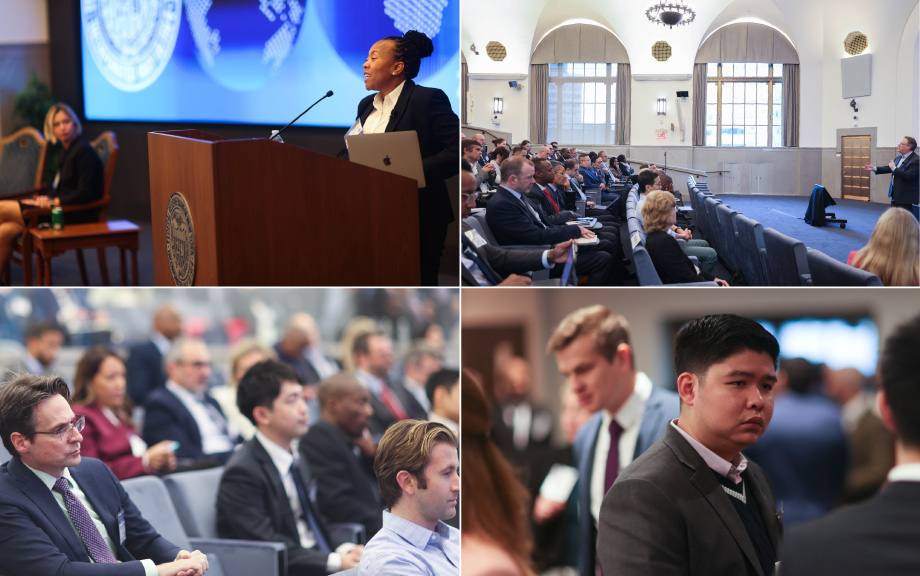
The New York Fed invites central bankers from around the world to its annual Central Banking Seminar each October. The Seminar, now in its 47th year, aims to educate central bankers about recent developments and current challenges in U.S. and global economies and financial markets, monetary policy, and financial supervision.
The seminar is designed to broaden the experience of high-potential leaders; participants must be nominated by their institutions to attend. About 200 central bankers from 90 countries joined another 25 leaders from the Federal Reserve System at this year’s seminar.
We spoke with some of the international participants about their expectations of the Central Banking Seminar and their experiences attending it. What follows are excerpts of those interviews, which have been edited for length and clarity.
Dragica Petrović, National Bank of Serbia: My greatest impression is how diverse the world is, how different all the countries are, but how similar our problems are, and how connected we all are. Some things that are happening in the world affect all of us. It’s incredible how every day at the Seminar, you see all different people. At our lunchtime discussion, there was a colleague from our neighboring country, Hungary. There was a deputy governor from the Nepalese Central Bank, and there was a colleague from South Africa. We were all, in a way, very different, but very similar. We are all small open economies facing the same challenges—geopolitical tensions affect all of us. We’re all very dependent on what’s happening in the larger economies, the U.S. and in the Eurozone.
The list of speakers is really impressive. When you see what kind of people are here to speak to us, that’s really very motivating for us to express the wish to participate. I’m impressed that all these important people, including the president of the New York Fed, take the time to come here and transfer their knowledge.
Leonard Setshegetso, Bank of Botswana: This is a congregation of people who deal with monetary policy and financial stability. I find myself in the research and financial stability department, which formulates the bank’s monetary policy framework and also the communication framework. By coming here, I’ll be in a better place to interact with people who work on my same subject, and, of course, bring lessons back home in terms of formulation and implementation of policies.
We come here on the back of very uncertain markets, geopolitical tensions, economic and financial fragmentation. There’s a lot of uncertainty in markets. We are in a space where we don’t know what’s going to happen. We’re waiting for the data. The data will tell us. You need to be with the right kind of people to talk about these issues, understand the challenges and experiences. I believe I’ll come out of this process much more learned.
The Seminar coincides with the International Monetary Fund and the World Bank’s annual meetings. Many key publications come out the week of the Seminar, including the World Economic Outlook and the Global Financial Stability Report. When you look at these two outputs from the IMF, that’s essentially what we’re discussing here in New York.
Muuka Madubeko, Bank of Zambia: I think it’s bringing together potential leaders for the future. Participating in the Seminar helps to increase our precision. Looking at the U.S. or other economies: What can we learn from each other in terms of implementing monetary policy and enhancing payment systems? How are things developing in other countries? What tools are they using? We are looking at what countries are doing well. As growing leaders, this is an opportunity for us to learn from the experts and also network with other colleagues who are working in the same capacity and learn from each other.
Milciades Denis, Banco Nacional de Panama: We do not have monetary policy in Panama, because we use the U.S. dollar. We need to be aware of the changes to monetary policy from the Federal Reserve System. Our inflation is very much pegged to the U.S. Panama has been growing more than neighboring countries; our growth rate this year should be around 6 percent. As a banking system, we’ve been pretty conservative, but we also need to have information about what’s going on here in the U.S.
Neelam Dhungana Timsina, Nepal Rastra Bank: I have an opportunity to learn about what is happening in the global economy, how financial stability can be achieved, and how central banks can achieve monetary stability. We’re learning about the use of technology in different aspects of central banking and financial systems. What are the new technologies adopted by central banks? What are their benefits? What are the challenges created by these new technologies? And how can we be safe from these risks? These are all things that are discussed in the seminar. I am impressed with all the talented speakers, especially the former Governor of Reserve Bank of India, Dr. Raghu Ram Rajan.
Yeni Samuel Costa, Bank of South Sudan: The conference is very useful. In one-on-one conversations, we manage to discuss issues that can help both central banks. When we go back, we can reflect where we are. One of the achievements is the topics themselves. Some people discover there are some gaps. Those gaps can be filled based on what they know from here. What we learned last year, we reflected back. To come here is to know more. This is one of the achievements of the Federal Reserve, to bring people together in person.
Elizabeth Mahoney is the Head of International Committees and Seminars at the New York Fed.
Ellen Simon is a corporate communications specialist in the Communications and Outreach Group at the New York Fed.
The views expressed in this article are those of the contributing authors and do not necessarily reflect the position of the New York Fed or the Federal Reserve System.










